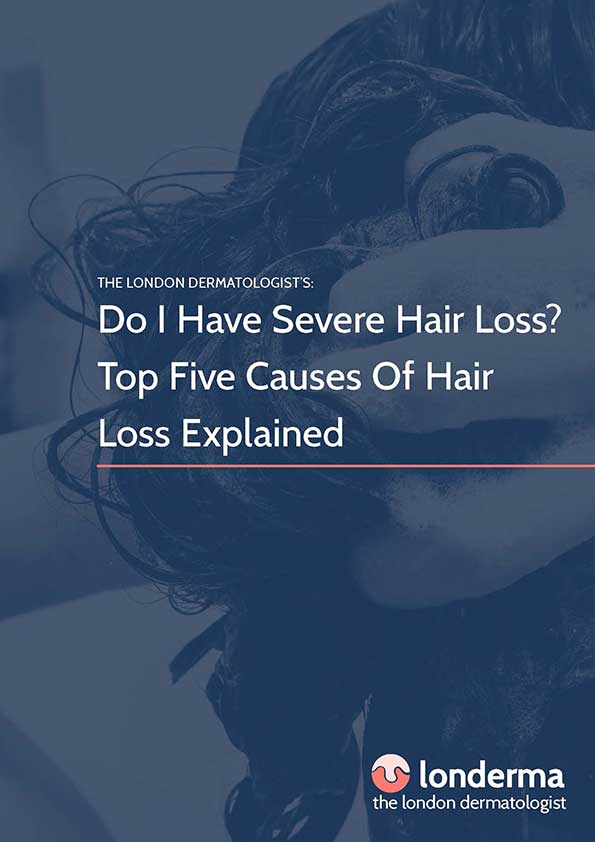Video consultations now available

Hair loss can occur at any age and can be very upsetting. Our hair and hair style is an important part of the way we express ourselves as individuals, and to lose one’s hair can be frightening.
There are hundreds of reasons we can lose our hair, many causing a slightly different pattern of loss, and each with a different long term outlook. Effective treatments are available, and whilst they may not be able to ‘cure’ the problem, many will restore lost hair and stop or slow progression.
The commonest cause of thinning is male or female ‘pattern hair loss’, also known as androgenetic alopecia. Typically, men notice thinning on the temples and crown, and women more generally at the front of the scalp. This is a slow process that occurs over many years, but which can occur much younger in some people than others. If this is the cause, your dermatologist may recommend treatment with minoxidil lotion which can reverse the process. Occasionally tablet treatment to control the hormonal effects on the follicle is recommended.
Increased hair shedding, with noticeable extra hair fall when brushing, combing, or washing hair leading to thinning may be caused by telogen effluvium, a common condition which can be due to hormonal changes, stress, illness, pregnancy, iron deficiency, medication or thyroid problems. The condition is often alarming and can occur fairly suddenly causing noticeable thinning, but does not cause complete baldness and often completely recovers, especially after correction of any underlying problem.
Sudden patchy loss of hair, leaving areas of total baldness may be caused by alopecia areata, a condition that affects up to 1 in 50 people, where the immune system attacks local hair follicles. Many people’s hair growth will recover, but this can be encouraged by injection of steroid into the area of skin containing the hair follicles every 6 weeks or use of other medications. About 1 in 5 people will not recover and this is more likely is hair loss if total or near-total, or if the hairline at the front, sides or back is affected.
People who use hot combing, braiding, chemical relaxants or tight extensions may notice hair loss at the top of the scalp, a condition dermatologists call centrifugal cicatricial alopecia, a condition which is important to recognise early because it can become permanent and severe if it is not picked up. Tying hair back tightly or using braids may cause traction alopecia, a condition which is reversible but which can become permanent if the follicles are badly damaged.
Women who have been through the menopause may develop a receding frontal hairline, different from female-pattern hair loss with permanent scarring of the follicles. This recently recognised condition is called frontal fibrosing alopecia and can be treated using topical steroid lotions and tablets that switch off the inflammation in the skin that causes the problem. Early diagnosis is key.
The first step if you are losing your hair is getting a diagnosis, and preferably doing this as early as possible, in other words finding out exactly what process is causing the hair to thin or fall out. If you are concerned then you should see a dermatologist. Dermatologists are the medical specialists that deal specifically with hair loss and hair issues.
Your dermatologist will discuss your problem with you and ask pertinent questions about whether you have noticed increased shedding, bald patches or scalp irritation. They will inquire in detail about any other recent illnesses of life events, diet, relevant previous or current medical problems or family history of hair loss.
The dermatologist will then examine your scalp and hair to assess the pattern of loss, the health of the skin and hair follicles which may be assessed at 20 times magnification with an illuminating instrument called a dermatoscope.
If appropriate, blood tests may be recommended to check iron stores, hormones and antibody levels. Sometimes a small sample of scalp skin may be taken for examination under a microscope to count and assess the follicles individually.
There are hundreds of reasons why hair loss may occur. If you are concerned you should not feel embarrassed to seek help from a dermatologist who will understand what you are going through and will be able to help.
 eBook Download: Do I Have Severe Hair Loss? Top Five Causes Of Hair Loss Explained
eBook Download: Do I Have Severe Hair Loss? Top Five Causes Of Hair Loss Explained